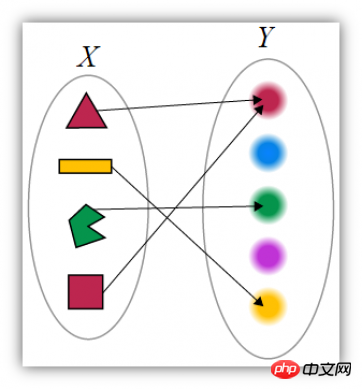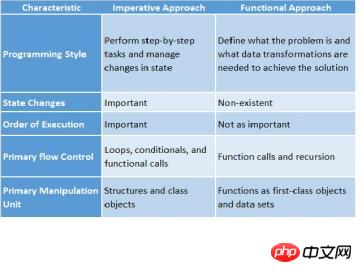 Web Front-end
Web Front-end
 JS Tutorial
JS Tutorial
 Detailed introduction to functional programming using JavaScript (1) (picture)
Detailed introduction to functional programming using JavaScript (1) (picture)
Detailed introduction to functional programming using JavaScript (1) (picture)
This article is the first article in the functional programming series. Here I will briefly introduce the programming paradigm and then jump straight into the concept of functional programming using Javascript, since JavsScript is one of the most recognized functional programming languages. Readers are encouraged to learn more about this fascinating concept through the References section.
Programming Paradigm
Programming paradigm is a framework composed of tools for thinking about problems and realizing the vision of the problem. Many modern languages are polyparadigm (or multi-paradigm): they support many different programming paradigms, such as object-oriented, metaprogramming, functional, procedural, etc.

Functional programming paradigm
Functional programming is like a hydrogen-powered car - advanced and futuristic, but not yet widely adopted . In contrast to imperative programming, it consists of a sequence of statements that update the global state at execution time. Functional programming turns calculations into expression evaluations. These expressions are all composed of pure mathematical functions, which are first-class (can be used and processed as normal values) and have no side effects.

Functional programming values the following values:
Functions are a first-class priority
We should treat functions with other elements in a programming language Class objects are treated similarly. In other words, you can store functions in variables, create functions dynamically, and return functions or pass functions to other functions. Let's look at an example...

A string can be saved as a variable, and functions can also be used, for example:
var sayHello = function() { return “Hello” };A string can be saved as Object fields and functions can also be used, for example:
var person = {message: “Hello”, sayHello: function() { return “Hello” }};A string can be created when it is used again, and functions can also be used, for example:
“Hello ” + (function() { return “World” })(); //=> Hello WorldA string can be passed to the function as an input parameter , then the function can also be used:
function hellloWorld(hello, world) { return hello + world() }A string can be used as the function return value, and the function can also be used, for example:
return “Hello”;
return function() { return “Hello”};Advanced case

If a function takes other functions as input parameters or as return values, it is called a higher-order function. We have just seen an example of a higher-order function. Next, let's look at a more complex situation.
Example 1:
[1, 2, 3].forEach(alert); // alert 弹窗显示“1" // alert 弹窗显示 "2" // alert 弹窗显示 "3”
Example 2:
function splat(fun) {
return function(array) {
return fun.apply(null, array);
};
}
var addArrayElements = splat(function(x, y) { return x + y });
addArrayElements([1, 2]);
//=> 3FavoritePure function

Pure function will not have other side effects. The so-called side effects refer to the modification of the external state of the function caused by the function. . For example:
Modify a certain variable
Modify the data structure
For an external variable Set a field
Throw an exception or pop up an error message
The simplest example is a mathematical function. The Math.sqrt(4) function always returns 2. It will not use any other chilling information, such as status or setting parameters. Mathematical functions never cause any side effects.
Avoid modifying state

Functional programming supports pure functions. Such functions cannot change data, so they are mostly used to create immutable data. In this way, there is no need to modify an existing data structure, and it can efficiently create a new one.
You may wonder, if a pure function produces an immutable return value by changing some local data, Is it allowed? The answer is yes.
Very few data types in JavaScript are immutable by default. String is an example of a data type that cannot be changed:
var s = "HelloWorld";
s.toUpperCase();
//=> "HELLOWORLD"
s;
//=> "HelloWorld"Benefits of immutable state
• Avoid confusion and increase program accuracy: In complex systems, most of the Bugs are caused when state is modified by external client code within the program.
• Establish "fast and concise" multi-threaded programming: If multiple threads can modify the same shared value, you have to obtain the value synchronously. This is a tedious and error-prone programming challenge for experts.
Software transactional memory and the Actor model provide direct processing of modifications in a thread-safe manner.
Use recursion instead of loop calls

递归是最有名的函数式编程技术。如果您还不知道它的话,那么可以理解为递归函数就是一个可以调用自己的函数。
替代反复循环的最经典方式就是使用递归,即每次完成函数体操作之后,再继续执行集合里的下一项,直到满足结束条件。递归还天生符合某些算法实现,比如遍历树形结构(每个树枝都是一颗小树)。
在任何语言里,递归都是一项重要的函数式编程方式。很多函数语言甚至要求的更加严格:只支持递归遍历,而不支持显式的循环遍历。这需要语言必须保证消除了尾端调用,这是 JavasSrip 不支持的。
惰性求值优于激进计算
数学定义了很多无穷集合,比如自然数(所有的正整数)。他们都是符号表示。任意特定有限的子集都在需要时求值。我们将其称之为惰性求值(也叫做非严格求值,或者按需调用,延迟执行)。及早求值会强迫我们表示出所有无穷数据,而这显然是不可能的。
很多语言都默认是惰性的,有些也提供了惰性数据结构以表达无穷集合,并在需要时对自己进行精确计算。
很明显一行代码 result = compute() 所表达的是将 compute() 的返回结果赋值给 result。但是 result 的值究竟是多少只有其被用到的时候才有意义。
可见策略的选择会在很大程度上提高性能,特别是当用在链式处理或者数组处理的时候。这些都是函数式程序员所喜爱的编程技术。
这就开创可很多可能性,包括并发执行,并行技术以及合成。
但是,有一个问题,JavaScrip 并不对自身进行惰性求值。话虽如此,Javascript 里的函数库可以有效地模拟惰性求值。
闭包的全部好处
所有的函数式语言都有闭包,然而这个语言特性经常被讨论得很神秘。闭包是一个函数,这个函数有着对内部引用的所有变量的隐式绑定。换句话说,该函数对它引用的变量封闭了一个上下文。JavaScript 中的闭包是能够访问父级作用域的函数,即使父级函数已经调用完毕。
function multiplier(factor) {
return function(number) {
return number * factor;
};
}
var twiceOf = multiplier(2);
console.log(twiceOf(6));
//=> 12声明式优于命令式编程
函数式编程是声明式的,就像数学运算,属性和关系是定义好的。运行时知道怎么计算最终结果。阶乘函数的定义提供了一个例子:
factorial(n) = 1 if n = 1
n * factorial(n-1) if n > 1
该定义将 factorial(n) 的值关联到 factorial(n-1),是递归定义。特殊情况下的 factorial(1) 终止了递归。
var imperativeFactorial = function(n) {
if(n == 1) {
return 1
} else {
product = 1;
for(i = 1; i <= n; i++) {
product *= i;
}
return product;
}
}
var declarativeFactorial = function(n) {
if(n == 1) {
return 1
} else {
return n * factorial(n - 1);
}
}从它实现阶乘计算来看,声明式的阶乘可能看起来像“命令式”的,但它的结构更像声明式的。
命令式阶乘使用可变值、循环计数器和结果来累加计算后的结果。这个方法显式地实现了特定的算法。不像声明式版本,这种方法有许多可变步骤,导致它更难理解,也更难避免 bug 。

函数式JavaScript库
有很多函数式库:underscore.js, lodash,Fantasy Land, Functional.js, Bilby.js, fn.js, Wu.js, Lazy.js, Bacon.js, sloth.js, stream.js, Sugar, Folktale, RxJs 等等。
函数式程序员工具包
map(), filter(), 和 reduce()函数 构成了函数式程序员工具包的核心。 纯高阶函数成了函数式方法的主力。事实上,它们是纯函数和高阶函数应该仿效的典型。它们用一个函数作为输入,返回没有副作用的输出。
The above is the detailed content of Detailed introduction to functional programming using JavaScript (1) (picture). For more information, please follow other related articles on the PHP Chinese website!

Hot AI Tools

Undresser.AI Undress
AI-powered app for creating realistic nude photos

AI Clothes Remover
Online AI tool for removing clothes from photos.

Undress AI Tool
Undress images for free

Clothoff.io
AI clothes remover

AI Hentai Generator
Generate AI Hentai for free.

Hot Article

Hot Tools

Notepad++7.3.1
Easy-to-use and free code editor

SublimeText3 Chinese version
Chinese version, very easy to use

Zend Studio 13.0.1
Powerful PHP integrated development environment

Dreamweaver CS6
Visual web development tools

SublimeText3 Mac version
God-level code editing software (SublimeText3)

Hot Topics
 1385
1385
 52
52
 Simple JavaScript Tutorial: How to Get HTTP Status Code
Jan 05, 2024 pm 06:08 PM
Simple JavaScript Tutorial: How to Get HTTP Status Code
Jan 05, 2024 pm 06:08 PM
JavaScript tutorial: How to get HTTP status code, specific code examples are required. Preface: In web development, data interaction with the server is often involved. When communicating with the server, we often need to obtain the returned HTTP status code to determine whether the operation is successful, and perform corresponding processing based on different status codes. This article will teach you how to use JavaScript to obtain HTTP status codes and provide some practical code examples. Using XMLHttpRequest
 How to get HTTP status code in JavaScript the easy way
Jan 05, 2024 pm 01:37 PM
How to get HTTP status code in JavaScript the easy way
Jan 05, 2024 pm 01:37 PM
Introduction to the method of obtaining HTTP status code in JavaScript: In front-end development, we often need to deal with the interaction with the back-end interface, and HTTP status code is a very important part of it. Understanding and obtaining HTTP status codes helps us better handle the data returned by the interface. This article will introduce how to use JavaScript to obtain HTTP status codes and provide specific code examples. 1. What is HTTP status code? HTTP status code means that when the browser initiates a request to the server, the service
 What are the benefits of using C++ lambda expressions for functional programming?
Apr 17, 2024 am 10:18 AM
What are the benefits of using C++ lambda expressions for functional programming?
Apr 17, 2024 am 10:18 AM
C++ lambda expressions bring advantages to functional programming, including: Simplicity: Anonymous inline functions improve code readability. Code reuse: Lambda expressions can be passed or stored to facilitate code reuse. Encapsulation: Provides a way to encapsulate a piece of code without creating a separate function. Practical case: filtering odd numbers in the list. Calculate the sum of elements in a list. Lambda expressions achieve the simplicity, reusability, and encapsulation of functional programming.
 How to optimize Golang functional programs using lazy evaluation?
Apr 16, 2024 am 09:33 AM
How to optimize Golang functional programs using lazy evaluation?
Apr 16, 2024 am 09:33 AM
Lazy evaluation can be implemented in Go by using lazy data structures: creating a wrapper type that encapsulates the actual value and only evaluates it when needed. Optimize the calculation of Fibonacci sequences in functional programs, deferring the calculation of intermediate values until actually needed. This can eliminate unnecessary overhead and improve the performance of functional programs.
 Common mistakes and pitfalls of golang functional programming
Apr 30, 2024 pm 12:36 PM
Common mistakes and pitfalls of golang functional programming
Apr 30, 2024 pm 12:36 PM
There are five common mistakes and pitfalls to be aware of when using functional programming in Go: Avoid accidental modification of references and ensure that newly created variables are returned. To resolve concurrency issues, use synchronization mechanisms or avoid capturing external mutable state. Use partial functionalization sparingly to improve code readability and maintainability. Always handle errors in functions to ensure the robustness of your application. Consider the performance impact and optimize your code using inline functions, flattened data structures, and batching of operations.
 Python Lambda expressions: abbreviated, concise, powerful
Feb 19, 2024 pm 08:10 PM
Python Lambda expressions: abbreviated, concise, powerful
Feb 19, 2024 pm 08:10 PM
pythonLambda expressions are a powerful and flexible tool for creating concise, readable, and easy-to-use code. They are great for quickly creating anonymous functions that can be passed as arguments to other functions or stored in variables. The basic syntax of a Lambda expression is as follows: lambdaarguments:expression For example, the following Lambda expression adds two numbers: lambdax,y:x+y This Lambda expression can be passed to another function as an argument as follows: defsum( x,y):returnx+yresult=sum(lambdax,y:x+y,1,2)In this example
 Python Lambda expressions: Uncovering the power of anonymous functions
Feb 24, 2024 am 09:01 AM
Python Lambda expressions: Uncovering the power of anonymous functions
Feb 24, 2024 am 09:01 AM
Lambda expression in python is another syntax form of anonymous function. It is a small anonymous function that can be defined anywhere in the program. A lambda expression consists of a parameter list and an expression, which can be any valid Python expression. The syntax of a Lambda expression is as follows: lambdaargument_list:expression. For example, the following Lambda expression returns the sum of two numbers: lambdax,y:x+y. This Lambda expression can be passed to other functions, such as the map() function: numbers=[ 1,2,3,4,5]result=map(lambda
 What are the advantages and disadvantages of Java functions compared to other functional programming languages?
Apr 24, 2024 pm 02:51 PM
What are the advantages and disadvantages of Java functions compared to other functional programming languages?
Apr 24, 2024 pm 02:51 PM
Java functional programming advantages include simplicity, composability, concurrency, test-friendliness, and performance. Disadvantages include learning curve, difficulty in debugging, limited flexibility, and performance overhead. Its key features include pure functions without side effects, data processing pipelines, stateless code, and efficient streaming APIs.




